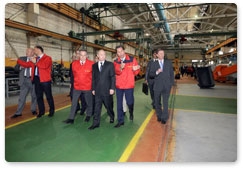Prime Minister Vladimir Putin visits the Tver Excavator Plant and talks to workers there
Tver is one of the oldest cities in Russia, the capital of Tver principality, famous for its attempts to compete with Moscow for the right to rule Russia. The fire of 1763 played an important role in shaping the present-day visage of the city of Tver. After the fire, the city was rebuilt using urban planning methods similar to that employed in the construction of Rome, Versailles and St Petersburg.
Today Tver is the largest industrial and cultural centre of the Upper Volga region. As of January 1, 2011, the population of Tver was 404,100. 216,700 residents are employed in the socio-economic sector. The most developed industries in Tver are engineering and metal processing, as well as production of building materials, printing, chemical and food industries.
In 2010 local industrial companies produced goods with an estimated value of 60.7 billion roubles (105, 4% in comparison to 2009), while processing industries produced goods with an estimated value of 47.1 billion roubles (103.2% in comparison to 2009).
Many Tver businesses are considered to be of national importance: Tver Rail Car Plant produces 98% of all Russian train cars; "Tverstroimash manufactures 40% of trailers used to transport heavy machinery; Tver Printing Plant of Children's Literature is one of top five printing companies in Russia; DKS produces various electrical components used in running cables; and "United Bottling Group", one of the largest beverage plants in Eastern Europe. The region also has 20 banks and their branches.
The average monthly salary at small and medium business enterprises in Tver at year-end of 2010 has increased by 11% and amounts to 20,227 roubles. More than 3,000 small businesses and 11,000 individual entrepreneurs contribute 30% of tax proceeds to the city budget annually. In total, there are 75,000 residents employed in this sector.
The unemployment (officially registered) rate in Tver is 0.7%.
In 2010 the city administration allocated 17.8 billion roubles for the development of the city's economy and social sphere. 196,600 square metres of housing and office space were commissioned in 2010, which is 30.3% more than in 2009. The year-end profit of financially viable businesses and organisations increased by more than 33%.
The city has 11 public and eight private institutions of higher education, a Suvorov military school, 12 specialized secondary educational establishments, eight establishments of elementary vocational education and seven private establishments of elementary vocational education. Approximately 50,000 students attend Tver higher education institutions and vocational schools. The education system also includes 69 general education schools attended by more than 36,000 people and 85 kindergartens, 77 of which are municipally funded.
Tver has 46 hospitals and outpatient clinics, of which20 are municipally funded. In addition, there are 12 GP practices (consulting rooms). The city has three theatres, the Academic Philharmonic Orchestra of Tver, six museums and 23 other culture facilities.

